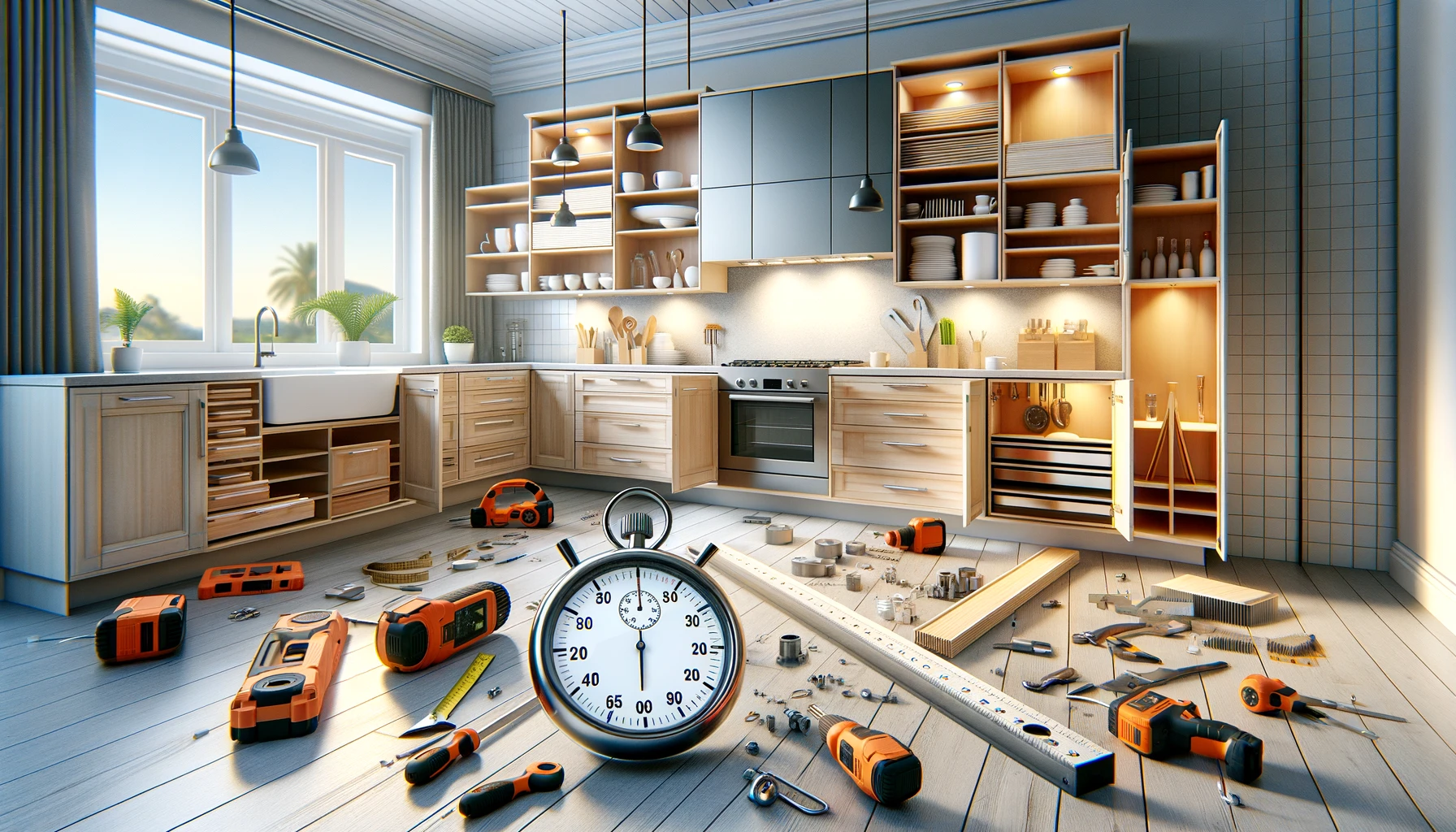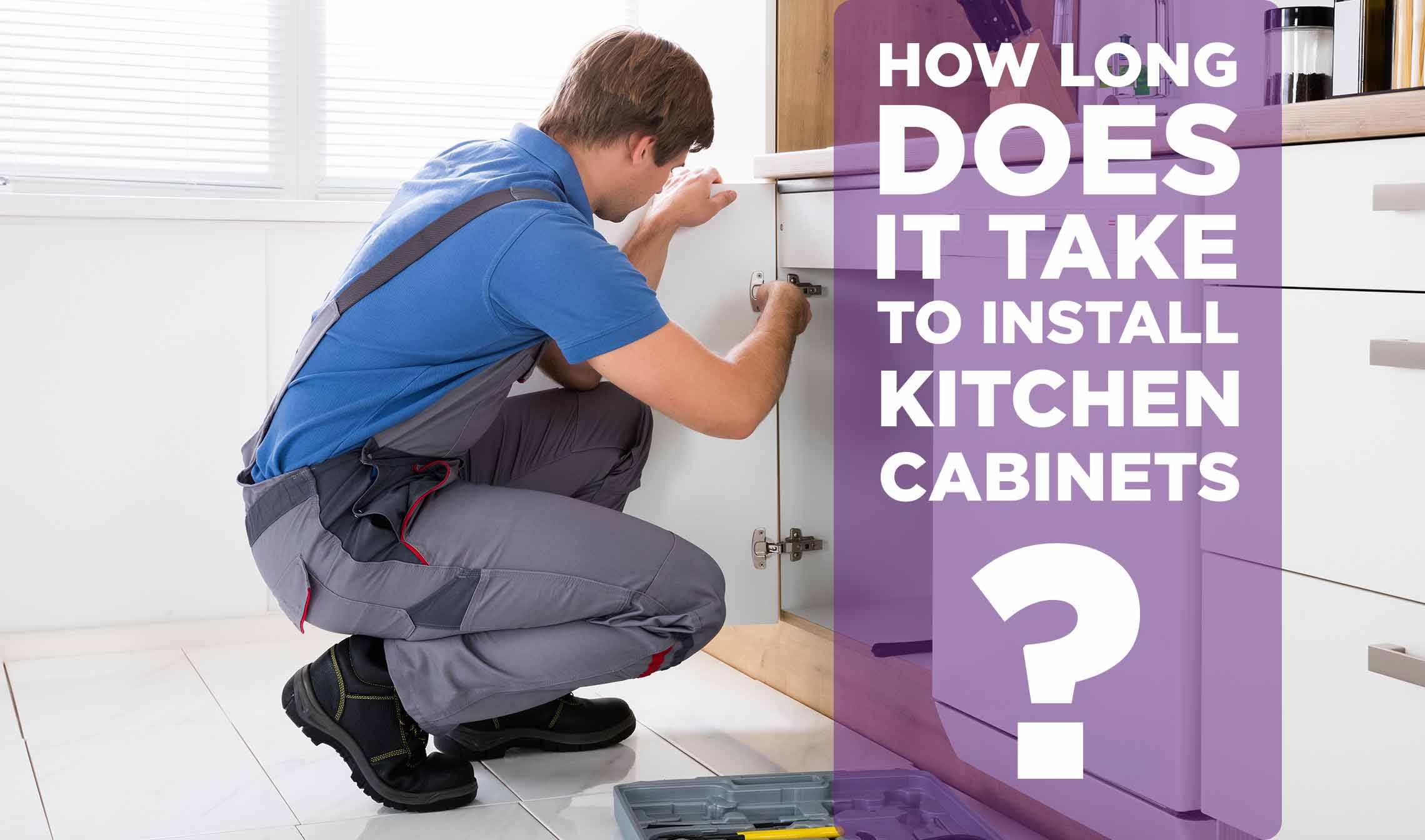Factors Influencing Installation Time: How Many Days To Install Kitchen Cabinets

The duration of kitchen cabinet installation is influenced by several factors, including the size and complexity of the kitchen, the number of cabinets, the type of cabinets, the existing kitchen layout, the availability of skilled labor, and the level of customization required.
Kitchen Size and Complexity
The size and complexity of the kitchen play a significant role in determining the installation time. Larger kitchens with intricate layouts and multiple islands or peninsulas will naturally require more time to install cabinets. Conversely, smaller kitchens with simpler layouts can be installed more quickly.
Number of Cabinets
The number of cabinets being installed is directly proportional to the installation time. More cabinets mean more work, and therefore more time is needed for installation. For example, a kitchen with 20 cabinets will take longer to install than a kitchen with 10 cabinets, assuming all other factors are equal.
Cabinet Type, How many days to install kitchen cabinets
The type of cabinets being installed also affects installation time.
- Stock cabinets are pre-made and readily available, making them quicker to install. They typically have standard sizes and designs, minimizing the need for customization.
- Semi-custom cabinets offer more flexibility in terms of size and finish, but they require some customization on site. This can add to the installation time.
- Custom cabinets are made to order and offer the highest level of personalization. They often require more intricate measurements and fitting, leading to a longer installation time.
Existing Kitchen Layout and Demolition
The existing kitchen layout and any required demolition can significantly impact the installation time. If the existing cabinets need to be removed or if significant changes are being made to the kitchen layout, this will add to the overall project timeline.
Availability of Skilled Labor
The availability of skilled labor is crucial for timely installation. If qualified installers are readily available, the installation can proceed smoothly. However, if there are delays in securing skilled labor, the installation process can be prolonged.
Customization Level
The level of customization required for the cabinets can also affect installation time. Cabinets with complex designs, unique finishes, or special features may require more time to install. For instance, cabinets with intricate moldings, custom hardware, or integrated appliances may necessitate additional time for fitting and installation.
Typical Installation Stages

The installation of kitchen cabinets is a multi-step process that involves careful planning, preparation, and execution. It is essential to understand the various stages involved to ensure a smooth and successful installation.
Preparing the Kitchen for Installation
Before beginning the installation, it is crucial to prepare the kitchen space. This involves clearing the area, removing existing cabinets, and ensuring the walls are ready for installation.
- Clear the area: Remove all items from the kitchen, including appliances, furniture, and any other obstacles that might hinder the installation process.
- Remove existing cabinets: If you are replacing existing cabinets, carefully dismantle them, taking note of any wiring or plumbing connections.
- Prepare the walls: Ensure the walls are smooth, level, and free of any debris. Patch any holes or cracks, and apply primer to the walls to provide a good surface for the cabinets.
Installing Cabinet Boxes
The cabinet boxes form the foundation of the kitchen. Their proper installation is crucial for the stability and alignment of the entire kitchen.
- Attaching the cabinet boxes: The cabinet boxes are typically attached to the walls using screws or nails. It is important to use the appropriate fasteners for the wall material.
- Aligning the cabinets: The cabinets must be aligned both horizontally and vertically. A level is essential for this step. Ensure that the cabinets are flush with each other and with the walls.
- Securing the cabinets: Once aligned, the cabinets should be secured to the walls and to each other. This ensures stability and prevents movement during use.
Installing Doors and Drawers
Once the cabinet boxes are installed, the doors and drawers can be attached.
- Installing hinges: Cabinet doors are typically attached using hinges. The hinges are mounted to the doors and the cabinet boxes, ensuring proper alignment and functionality.
- Installing drawer slides: Drawer slides are installed to provide smooth and reliable drawer operation. The slides are attached to the cabinet boxes and the drawers, ensuring proper alignment and functionality.
- Adjusting doors and drawers: After installation, doors and drawers may require adjustment to ensure they open and close smoothly. This may involve adjusting the hinges, slides, or the cabinet boxes themselves.
Installing Hardware and Accessories
Once the cabinets, doors, and drawers are installed, the final step is to install hardware and accessories.
- Installing cabinet pulls and knobs: Cabinet pulls and knobs are attached to the doors and drawers for easy opening and closing.
- Installing shelves: Shelves are often included with cabinets, and these are installed within the cabinet boxes.
- Installing other accessories: Other accessories, such as spice racks, drawer dividers, and lighting fixtures, may be installed at this stage.
Final Inspection and Clean-Up
After all the components are installed, a final inspection is essential.
- Checking for functionality: Ensure that all doors and drawers open and close smoothly, and that all hardware and accessories are properly installed.
- Checking for alignment: Verify that all cabinets are properly aligned and level.
- Cleaning up: Remove any debris or dust from the installation process.
Practical Considerations and Tips

Now that you have a good understanding of the factors that influence kitchen cabinet installation time, let’s delve into some practical considerations and tips to ensure a smooth and successful project.
Kitchen Cabinet Installation Timelines
The duration of your kitchen cabinet installation can vary significantly based on the size and complexity of your kitchen. Here’s a general guideline for typical installation times:
- Small Kitchen (under 100 square feet): 1-2 days
- Medium Kitchen (100-200 square feet): 2-3 days
- Large Kitchen (over 200 square feet): 3-5 days
These timelines are estimates and can be affected by factors such as the number of cabinets, the complexity of the design, and any unexpected issues that may arise during installation.
Kitchen Cabinet Installation Project Flowchart
A well-structured flowchart can help visualize the typical steps involved in a kitchen cabinet installation project. Here’s a breakdown of the key stages:
- Preparation: This stage involves clearing the kitchen space, removing existing cabinets, and preparing the walls for installation. It includes tasks like demolition, electrical work, and plumbing adjustments.
- Cabinet Delivery and Inspection: Once the cabinets are delivered, a thorough inspection is crucial to ensure all components are present and undamaged. This step also involves verifying the cabinet dimensions and design specifications.
- Installation: This is the core of the project where the cabinets are mounted to the walls, secured, and aligned. It may involve specialized tools and techniques depending on the cabinet type and design.
- Finishing Touches: This final stage involves installing cabinet doors and drawers, attaching hardware, and completing any necessary trim work. It also includes cleaning up the installation area.
Effective Communication with Contractors and Installers
Clear and open communication is essential for a successful kitchen cabinet installation project.
- Define Clear Expectations: Clearly communicate your vision for the kitchen, including desired cabinet styles, finishes, and functionalities. Discuss your budget and timeline expectations with the contractor.
- Regular Updates and Progress Reports: Request regular updates from the contractor and installers to stay informed about the project’s progress. Ask for clarification on any changes or delays.
- Address Concerns Promptly: Don’t hesitate to raise any concerns or questions that arise during the installation process. Promptly address issues to prevent them from escalating.
Preparing the Kitchen Space for Installation
Proper preparation is crucial for a smooth installation process.
- Clear the Kitchen: Remove all appliances, furniture, and personal belongings from the kitchen area to provide ample space for the installers to work.
- Protect Surfaces: Cover countertops, floors, and other surfaces with protective materials like drop cloths or plastic sheeting to prevent damage during the installation process.
- Prepare the Walls: Ensure the walls are clean, smooth, and ready for installation. If necessary, repair any cracks or holes and apply a primer for better adhesion.
Selecting the Right Cabinets for Your Kitchen
Choosing the right cabinets is essential for both functionality and aesthetics.
- Consider Your Kitchen’s Layout: Choose cabinets that complement your kitchen’s size and layout. Consider the amount of storage space you need and the placement of appliances.
- Evaluate Your Lifestyle: Select cabinets that meet your specific needs and lifestyle. For example, if you frequently cook, you may need more counter space and storage options.
- Budget and Material Choices: Set a budget and consider different cabinet materials, such as wood, laminate, or thermofoil. Each option offers unique advantages and price points.
Hiring Experienced and Reputable Installers
Hiring experienced and reputable installers is crucial for a successful kitchen cabinet installation project.
- Research and Get Recommendations: Research potential installers online and ask for recommendations from friends, family, or other professionals. Check online reviews and ratings to gauge their reputation.
- Verify Licensing and Insurance: Ensure the installers are properly licensed and insured to protect yourself from liability in case of accidents or damage during the installation process.
- Obtain Multiple Quotes: Get quotes from multiple installers to compare pricing and services. Discuss the scope of work, materials, and timelines in detail.
How many days to install kitchen cabinets – So, you’re thinking about getting new kitchen cabinets, huh? It usually takes a couple of days to install them, depending on the size and complexity of the job. While you’re waiting, why not add some coastal vibes to your bedroom with some coastal curtains ?
They’ll make you feel like you’re on vacation every day. Once those cabinets are in, you’ll have a brand new kitchen to show off!
So, you’re wondering how long it takes to install kitchen cabinets? It depends, but usually a couple of days. Maybe you’re also thinking about sprucing up your bedroom with some fresh vibes? Check out these green bedroom curtains uk for some serious style inspiration.
Once you’ve got the bedroom sorted, you can get back to those cabinets and imagine your new kitchen.
